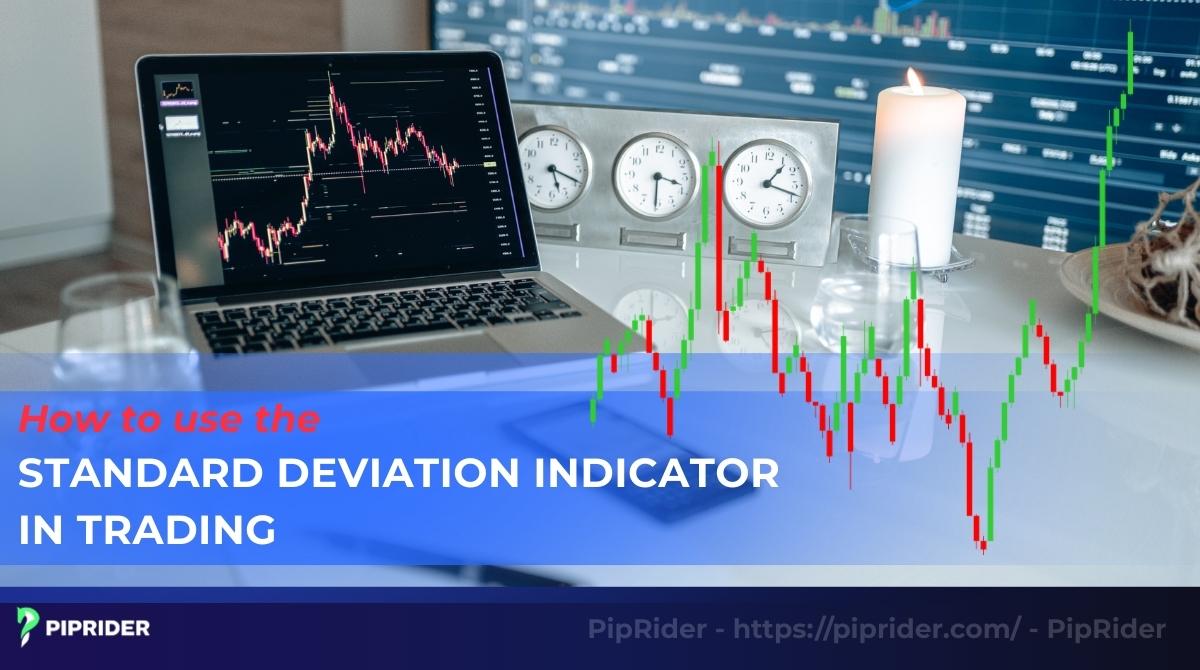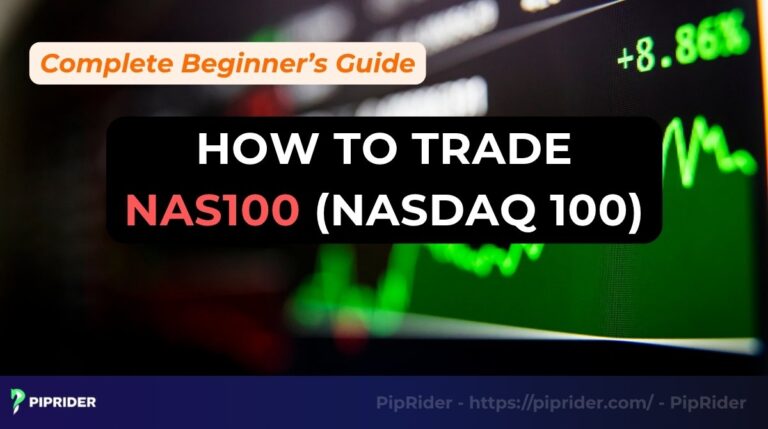The main risk in trading is being caught by sudden, unmeasured volatility shifts. Failed entries and unexpected stop-outs frequently occur when market stability changes without warning. The Standard Deviation indicator is the definitive tool to quantify this risk. It measures precisely how much price deviates from its average, giving you an objective measure of current market behavior.
This guide details the SD formula and shows you how to use it to objectively manage risk and avoid common trading mistakes.
Key Takeaways
- The Standard Deviation is a statistical tool that measures the size of recent price movements to gauge market volatility.
- A high reading signifies large price swings, while a low reading indicates a quiet, consolidating market.
- The indicator provides no directional trading signals; it only measures the intensity of price movement.
- A key strategy is anticipating breakouts after a period of extremely low standard deviation.
- This tool is the mathematical foundation for other crucial volatility tools, most notably the Bollinger Bands.
1. What Is The Standard Deviation Indicator?
In technical analysis, the Standard Deviation is a powerful statistical measure from the field of descriptive statistics designed to quantify the degree of price dispersion. In simple terms, the indicator shows how spread out recent price fluctuations are from their average.
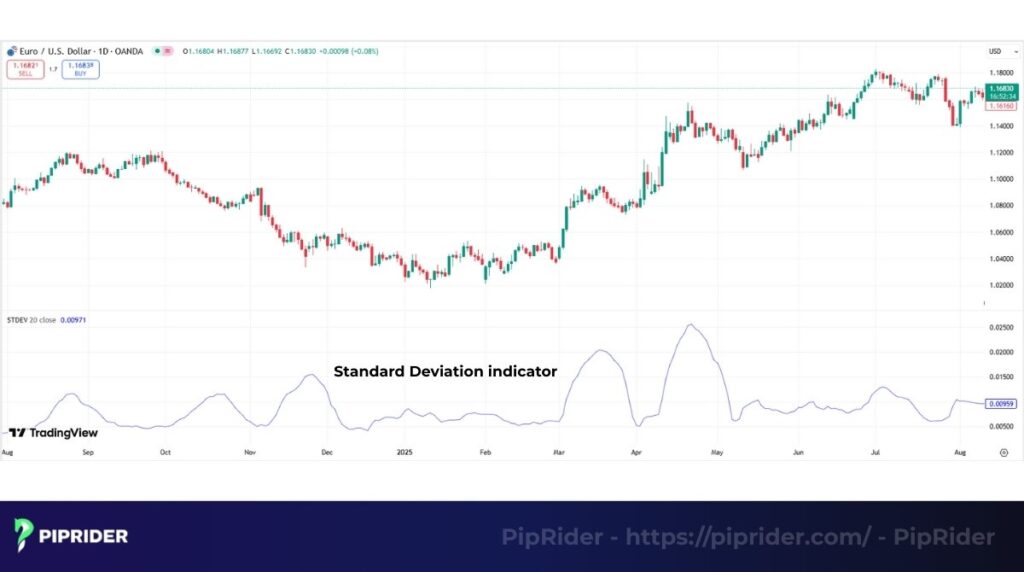
The concept itself is borrowed directly from the world of statistics but has been adapted for trading as a pure measure of market volatility. The indicator’s purpose is not to indicate if a trend is up or down. Instead, the tool answers a different, equally important question: “Is the market currently calm and quiet, or is it wild and chaotic?”
- When the indicator shows a low value, this signifies that the price is consolidating within a tight band around its average, a characteristic of a sideways market.
- A high Standard Deviation value means the price has been making large swings, far from its average. A high reading could indicate a robust, healthy trend, but it might also signify a final point of exhaustion right before a potential reversal.
This knowledge helps traders adapt their strategies. For example, attempting to use a trend-following strategy when the Standard Deviation indicator is flat is a recipe for frustration. Conversely, knowing when volatility is high helps traders determine when to widen their stop losses for proper risk management to avoid being shaken out by noise.
2. How To Calculate The Standard Deviation Indicator?
The formula for Standard Deviation is where many traders get intimidated. However, understanding the logic behind the Standard Deviation indicator formula is surprisingly simple. Manual calculation is never necessary, but knowing the steps a software takes provides a much deeper appreciation for what the indicator is actually revealing.
2.1. The Standard Deviation Formula
The formal statistical formula can look a bit intense, but the process involves a series of simple steps.
| Standard Deviation (σ) = √[Σ(x – μ)² / N] |
Where:
- σ = Standard Deviation
- Σ = Sum of x = Each value in the data set (e.g., each closing price)
- μ = The mean value (average) of the data set
- N = The total number of data points (the period)
2.2. The Calculation Process In Five Simple Steps
Let’s translate that formula into a clear, step-by-step process. The procedure is exactly what charting software does in a fraction of a second.
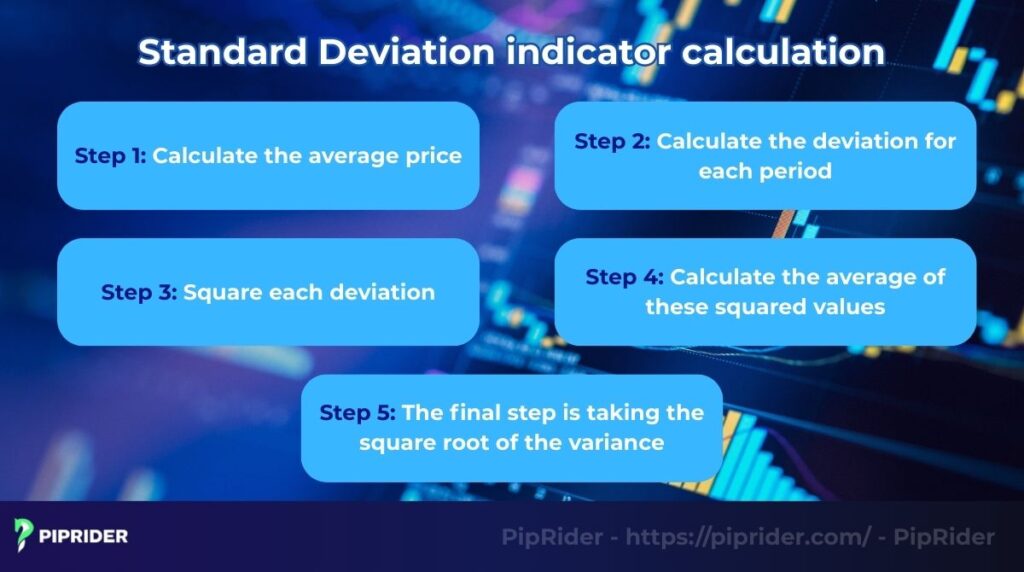
Step 1: Calculate the average price
First, the indicator calculates a simple moving average (SMA) of the price over a specific period. The most common setting is 20 periods.
Step 2: Calculate the deviation for each period
Next, the process looks at each of the 20 closing prices and calculates how far away that specific price was from the average calculated in Step 1.
Step 3: Square each price deviation
The calculation then takes each of those price deviation values from Step 2 and multiplies it by itself (squares it). Squaring the deviations makes all the values positive and gives more weight to the larger deviations.
Step 4: Calculate the average of these squared values
The process adds up all the squared values from Step 3 and divides by the period (20). This result is known as the “variance”.
Step 5: The final step is taking the square root of the variance
The final number is the Standard Deviation indicator value that is plotted as a single line on an indicator panel.
2.3. A Practical Example
Let’s say a 5-period setting is used for simplicity, and the last 5 closing prices were: 1.10, 1.12, 1.11, 1.13, 1.14.
- Mean value (μ): (1.10 + 1.12 + 1.11 + 1.13 + 1.14) / 5 = 1.12
- Deviations (x – μ): -0.02, 0, -0.01, +0.01, +0.02
- Squared Deviations (x – μ)²: 0.0004, 0, 0.0001, 0.0001, 0.0004
- Variance (Average of Step 3): (0.0004 + 0 + 0.0001 + 0.0001 + 0.0004) / 5 = 0.0002
- Standard Deviation (√Variance): √0.0002 ≈ 0.014
The resulting value of 0.014 is the Standard Deviation, representing the typical distance of the recent prices from their average.
3. Interpreting Standard Deviation Values
Now that the calculation is clear, let’s focus on the most important part: how to read the Standard Deviation indicator. The actual number produced by the indicator is less important than what that number reveals about the market’s current personality.
3.1. The Meaning Of High And Low Values
The most fundamental interpretation involves reading the indicator’s value to get an instant gauge of the market’s volatility.
- A low Standard Deviation value: A low reading indicates very little volatility. The price is trading in a tight, quiet range. This is a sign that the market is “asleep” or consolidating, and it’s often a terrible time to be in a trend-following trade.
- A high Standard Deviation value: A high reading indicates high volatility. The price is making large, energetic swings. A high reading could indicate a robust, healthy trend, but it might also signify a final point of exhaustion right before a potential reversal.
The key insight is that volatility is cyclical. Periods of low volatility are almost always followed by periods of high volatility, and vice versa.
3.2. Cues From The Normal Distribution (The 68-95-99.7 Rule)
Understanding the indicator’s statistical foundation can provide a significant advantage. In statistics, the “normal distribution” describes how data is typically spread out around an average. The statistical rule states that, in a normal market:
- Approximately 68% of recent price data is expected to fall within one standard deviation of the price mean.
- Approximately 95% of recent price data should be contained within two standard deviations of the mean.
- Roughly 99.7% of all recent price action should happen within three standard deviations.
In his book, “Bollinger on Bollinger Bands“, John Bollinger himself explains that the bands are deliberately set at two standard deviations to contain the vast majority of price action, making any move outside the bands a statistically significant event. This principle is the mathematical core of his indicator (Bollinger, 2001).
The implication for a trader is that any price move that goes beyond two standard deviations is a statistically significant event. A move of this magnitude is a sign of extreme volatility that is unlikely to be sustained, which is why such moves are often followed by a reversion back toward the average price.
4. Best Settings And Parameters For Different Trading Styles
Like most indicators, the Standard Deviation indicator can be adjusted to suit a specific trading style and timeframe. While the default settings are an excellent starting point, understanding the parameters allows for fine-tuning. The two main parameters available for adjustment are the period and the source price.
4.1. The Standard Deviation Parameters
Before looking at specific styles, a trader should understand what is actually being changed.
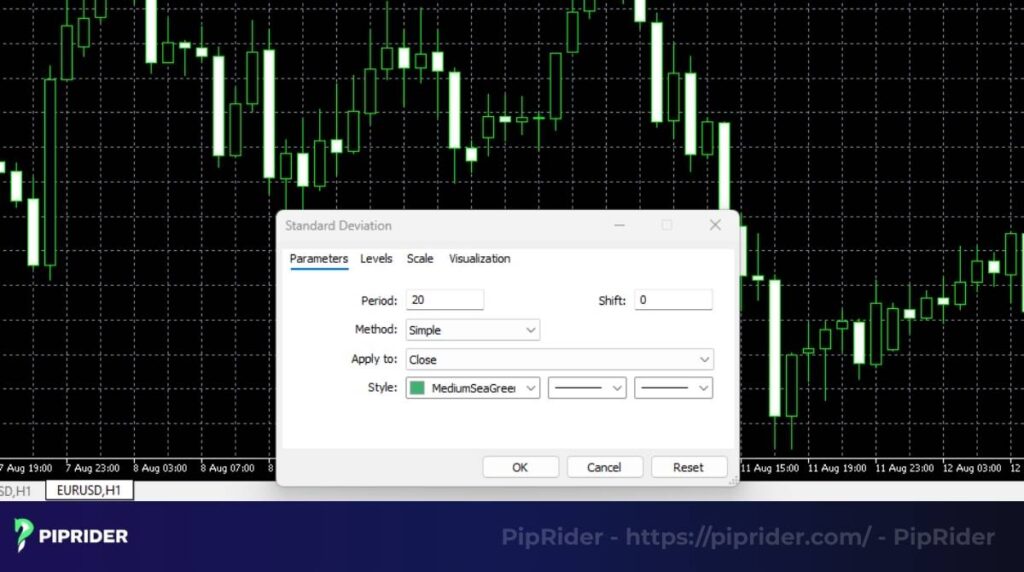
- Period: This is the lookback window for the calculation, typically set to 20 by default. A shorter period (e.g., 10) will make the indicator react more quickly to changes in volatility, while a longer period (e.g., 30) will make it smoother and slower.
- Source Price: This is the price data used in the calculation. The default is almost always the Close price of each candle, which is recommended for 99% of situations.
4.2. Recommended Settings For Your Trading Style
The key is to match the indicator’s sensitivity to the timeframe being traded. A scalper needs to see immediate shifts in volatility, while a position trader only cares about major, long-term volatility trends. The following table provides a straightforward guide for these adjustments.
| Trading Style | Recommended Period | Source Price | Timeframe Focus | Key Consideration |
| Scalping | 5 to 10 | Close | M1, M5, M15 | A shorter period is essential for scalping to see immediate volatility spikes around news or session opens. Be prepared for a lot of noise. |
| Day Trading | 20 (Standard) | Close | M15, H1 | The default 20-period setting is the perfect balance for day trading. The value is slow enough to filter out noise but fast enough to capture the day’s main volatility cycles. |
| Swing Trading | 20 to 30 | Close | H4, Daily | For swing trading, a trader can use the default or a slightly longer period like 30. This helps to ignore minor daily volatility and focus on the major weekly swings. |
| Position Trading | 50 or more | Close | Weekly, Monthly | A long-term investor might use a 50-period setting on a weekly chart to identify periods of historical market complacency (low volatility) or panic (high volatility). |
A sound piece of advice is to start with the default 20-period setting. The value is the most widely used and will give a solid, reliable reading of volatility across most market conditions and timeframes. Only after mastering its interpretation should a trader experiment with adjustments.
5. Standard Deviation In Trading Strategies
The Standard Deviation is not a standalone signal generator. Its real power emerges when used as a volatility filter within a broader trading strategy. Let’s explore two powerful strategies where the indicator plays a crucial role in improving timing and filtering out bad trades.
5.1. The Flat Breakout Strategy
This strategy is a popular way to use the Standard Deviation, based on the principle that periods of low volatility are often followed by explosive moves.
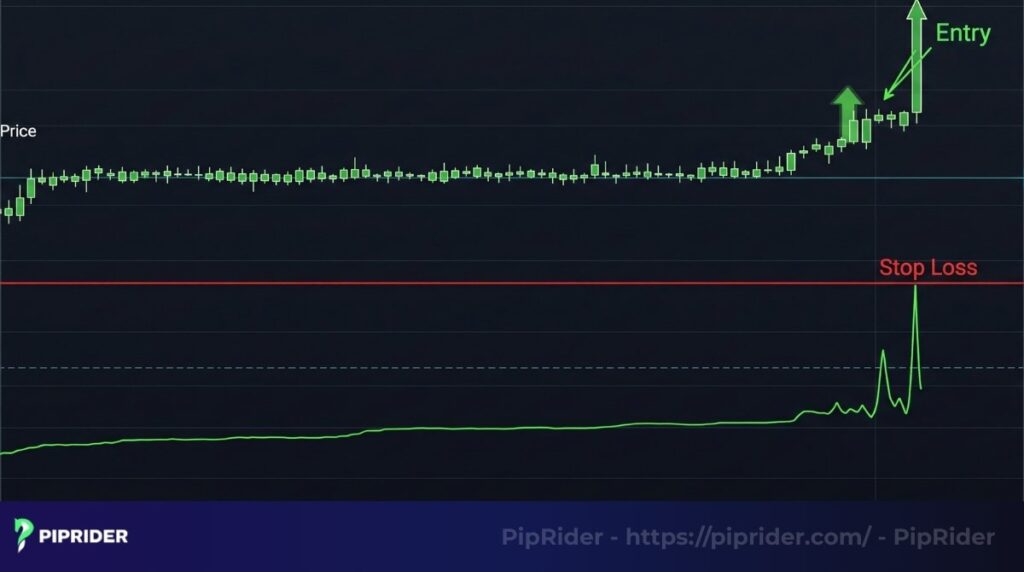
The Logic: The goal is to find a market that is “coiling up” like a spring. The Standard Deviation indicator allows traders to identify when the market is extremely quiet and ripe for a major move.
The Rules:
- Find the calm: Look for the Standard Deviation to be at or near its historical lows. A low reading shows that volatility has completely dried up and price is in tight consolidation.
- Identify the range: Draw support and resistance lines around the tight price range that is forming.
- Wait for the breakout: A trader must wait for a candle to close firmly outside the established support or resistance boundaries, which provides a clear entry point.
- Confirm with the indicator: At the moment of this move, the Standard Deviation should spike upwards sharply. Such a spike is confirmation that real energy is entering the market, and the breakout is likely to be genuine.
- Entry and risk: Enter on the breakout and place the stop loss just on the other side of the consolidation range.
Case Study (Pre-CPI Breakout):
During the first week of June 2024, the EUR/USD H4 chart showed characteristics of low volatility as the market braced for the US CPI release. Although specific commentary on the Standard Deviation indicator for NASDAQ-100 (NQ1!) is not readily available, broader market behavior supports the narrative of breakout following low volatility. On May 15, 2024, the NASDAQ-100 rallied significantly after the US CPI report, following a breakout pattern observed in major indices (Carew & Kamdar, 2024; Investors.com, 2024).
5.2. The Trend Reversal Strategy
The trend reversal strategy is a more contrarian approach. It aims to identify the end of a trend by spotting a point of unsustainable, climactic volatility.

The Logic: A trend often ends not with a whimper, but with a bang. This final, exhaustive move is often accompanied by a massive spike in volatility. The Standard Deviation indicator is used to spot this “climax”.
The Rules:
- Find the climax: Look for the Standard Deviation to surge to an extreme historical high. Such a move shows the market is in a state of near-panic or euphoria.
- Look for confirmation: This volatility surge alone is not enough. The signal should be combined with other forms of analysis, such as key Fibonacci levels or candlestick patterns, for confirmation.
- Entry and risk: Enter only after the price action has confirmed the reversal. Place your stop loss above the high (for a sell) or below the low (for a buy) of the reversal candle.
Case Study (The 2020 Market Bottom):
The most famous historical example of a volatility climax is the market bottom in March 2020. As the S&P 500 index crashed, the 20-day Standard Deviation spiked to levels not seen since the 2008 financial crisis.
According to historical data from TradingView, the indicator reached values over 5 times its normal average. A classic signal described by renowned trading psychologist Dr. Brett Steenbarger in his works like The Psychology of Trading marked the point of maximum fear just before one of the largest bull runs in history began (Steenbarger, 2002; TradingView, 2020).
6. Advantages And Disadvantages Of The Standard Deviation
Like any technical tool, the Standard Deviation has a specific job. The indicator is excellent for its specific purpose, but being aware of its limitations is crucial for long-term success.
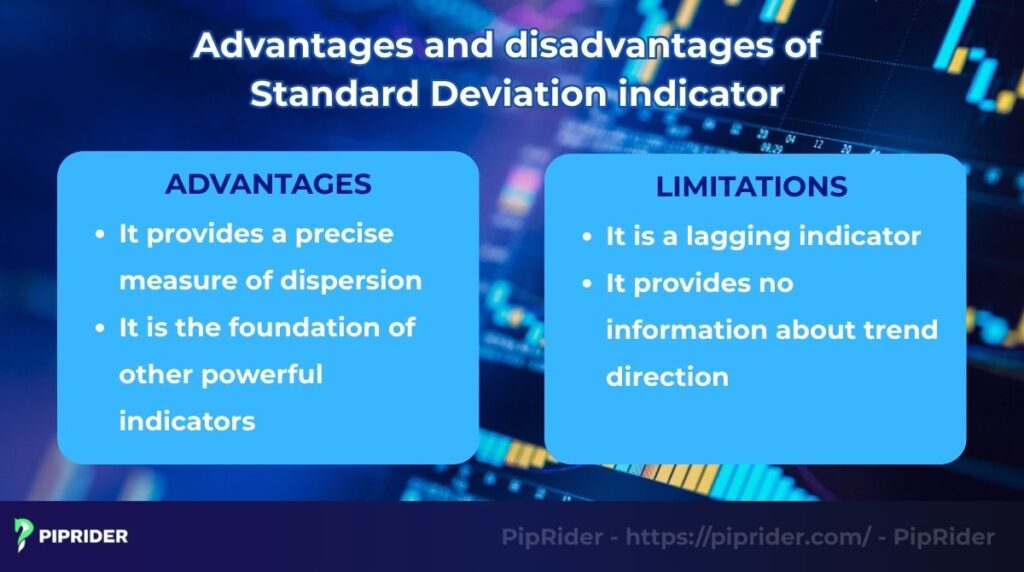
Here is a quick summary of the key advantages and limitations:
| Pros | Cons |
| Precise Volatility Measurement: Offers a mathematically exact, objective value for the market’s current price. | Lagging by Nature: As a reactive tool, the indicator only confirms volatility after a significant price move has already begun. |
| Foundation for Other Indicators: Understanding its calculation provides deeper insight into how other crucial tools, like Bollinger Bands, function. | Lack of Directional Signals: Provides zero information about whether the price is moving up or down, making it unsuitable as a standalone indicator. |
7. Frequently Asked Questions (FAQs)
Here are some quick, no-nonsense answers to the questions traders ask most frequently about the Standard Deviation indicator.
8. Conclusion
In the complex world of financial markets, understanding direction is only one part of the equation. The other, equally crucial part is understanding volatility. The Standard Deviation indicator is not just another line on the chart, but a tool for proactive risk assessment, serving as a direct, mathematical measure of the market’s current state of chaos or calm.
While offering no directional signals on its own, its true power lies in its role as a master context tool for robust trading systems. By learning how to use the indicator in trading, a trader can better anticipate explosive breakouts and define clear entry points and exit points.
This guide has provided the foundational knowledge. The next step is to apply it. Add the indicator to your charts, test the strategies discussed, and learn to respect the rhythm of volatility. To continue the journey, explore more guides in our best technical indicators and Learn Forex category right here on Piprider.


